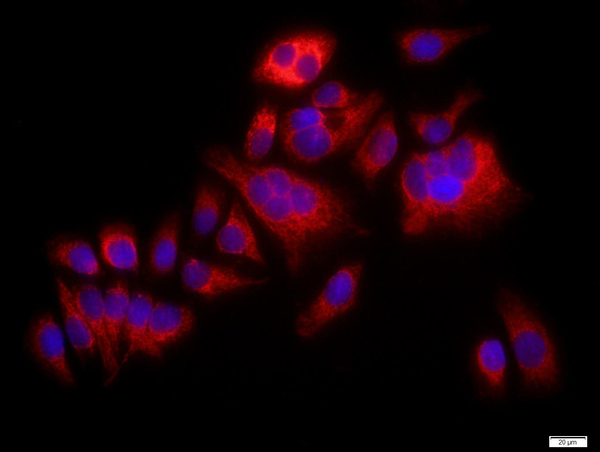
Immunohistochemical staining of formalin fixed and paraffin embedded human breast cancer tissue sections using Anti-Phospho-p38 MAPK (Thr180/Tyr182) RM243 at a 1:1000 dilution.
anti-Phospho-p38 MAPK (pT180/pY182) (human), Rabbit Monoclonal (RM243)
REV-31-1125-00
ApplicationsWestern Blot, ImmunoHistoChemistry
Product group Antibodies
ReactivityHuman
TargetMAPK14
Overview
- SupplierRevMAb Biosciences
- Product Nameanti-Phospho-p38 MAPK (pT180/pY182) (human), Rabbit Monoclonal (RM243)
- Delivery Days Customer10
- ApplicationsWestern Blot, ImmunoHistoChemistry
- CertificationResearch Use Only
- ClonalityMonoclonal
- Clone IDRM243
- Gene ID1432
- Target nameMAPK14
- Target descriptionmitogen-activated protein kinase 14
- Target synonymsCSBP, CSBP1, CSBP2, CSPB1, EXIP, Mxi2, PRKM14, PRKM15, RK, SAPK2A, p38, p38ALPHA, mitogen-activated protein kinase 14, CSAID-binding protein, MAP kinase 14, MAP kinase Mxi2, MAP kinase p38 alpha, MAX-interacting protein 2, cytokine suppressive anti-inflammatory drug binding protein, mitogen-activated protein kinase p38 alpha, p38 MAP kinase, p38 mitogen activated protein kinase, p38alpha Exip, stress-activated protein kinase 2A
- HostRabbit
- IsotypeIgG
- Protein IDQ16539
- Protein NameMitogen-activated protein kinase 14
- Scientific Descriptionp38 MAP kinase (MAPK) participates in a signaling cascade controlling cellular responses to cytokines and stress. Four isoforms of p38 MAPK, p38alpha, beta, gamma (also known as Erk6 or SAPK3), and delta (also known as SAPK4) have been identified. p38 MAPK is activated by a variety of cellular stresses including osmotic shock, inflammatory cytokines, lipopolysaccharide (LPS), UV light and growth factors. MKK3, MKK6, and SEK activate p38 MAPK by phosphorylation at Thr180 and Tyr182. Activated p38 MAPK has been shown to phosphorylate and activate MAPKAP kinase 2 and to phosphorylate the transcription factors ATF-2, Max and MEF2. MAP kinases act as an integration point for multiple biochemical signals, and are involved in a wide variety of cellular processes such as proliferation, differentiation, transcription regulation, and development. - Recombinant Antibody. This antibody reacts to p38 MAPK only when dual phosphorylation at Thr180 and Tyr182 is observed. There is no cross-reactivity with p38 MAPK without dual phosphorylation at Thr180 and Tyr182. Applications: WB, IHC. Source: Rabbit. Liquid. 50% Glycerol/PBS with 1% BSA and 0.09% sodium azide. p38 MAP kinase (MAPK) participates in a signaling cascade controlling cellular responses to cytokines and stress. Four isoforms of p38 MAPK, p38alpha, beta, gamma (also known as Erk6 or SAPK3), and delta (also known as SAPK4) have been identified. p38 MAPK is activated by a variety of cellular stresses including osmotic shock, inflammatory cytokines, lipopolysaccharide (LPS), UV light and growth factors. MKK3, MKK6, and SEK activate p38 MAPK by phosphorylation at Thr180 and Tyr182. Activated p38 MAPK has been shown to phosphorylate and activate MAPKAP kinase 2 and to phosphorylate the transcription factors ATF-2, Max and MEF2. MAP kinases act as an integration point for multiple biochemical signals, and are involved in a wide variety of cellular processes such as proliferation, differentiation, transcription regulation, and development.
- ReactivityHuman
- Storage Instruction-20°C
- UNSPSC12352203





